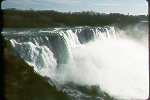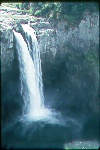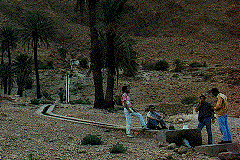 HYDROPOWER
HYDROPOWER HYDROPOWER
HYDROPOWER![]()
![]()
![]()
![]()
 History
of Hydropower
History
of Hydropower
Man’s oldest source of power is from flowing water. Ancient civilizations used rivers to drive numerous mechanisms such as grain mills. With the advent of turbine technologies, man discovered a way to convert kinetic energy in moving water to mechanical power.
In the United States, the first hydropower plant was built in 1880 in Grand Rapids, Michigan. Large scale construction of these power plants occurred in the 1930s and ‘40s as a part of Franklin D. Roosevelt’s “New Deal” programs. These efforts were intended to provide electricity to remote areas of the country where private utility companies were absent. Since rivers are abundant, hydroelectricity is widely used by both rural and urban settlements.
 Current
Hydropower Use
Current
Hydropower Use
Globally, hydropower contributes to 24 percent of the world’s electricity, supplying over 1 billion people with power. Providing electricity for 35 million households in the U.S., hydropower is the most widely used non-polluting source. Currently, between 10 and 13 percent of our nation’s power- 77,000 MW- comes from hydropower facilities. Equivalent to almost 500 million barrels of oil a year, hydropower generation is the most efficient form of energy production.
How Does Hydropower Work?
Using a dam, reservoir, turbines, generators, and penstocks (pipes), hydropower plants convert the energy in moving water to electricity. The height of the water fall (head) and the volume of flow determine the quantity of electricity generated. The higher the head and greater the volume, the more energy produced. Dams store the water that is eventually channeled to the powerhouse where the water turns the turbines. After the generators produce electricity, it is transferred to an electrical power substation and then transmitted to consumers.
Benefits
of Hydropower
Hydropower is cheap, non-polluting, and many small facilities (less than 30 MW) are considered renewable energy sources. Unlike other sources of energy like nuclear power, the costs of large scale plants is declining because the facilities have been paid for by federal or state projects. Dams and reservoirs also provide recreational opportunities, flood control, irrigation, refuges for wildlife, water supply, and transportation.
Concerns
of Hydropower 
While there are many benefits to hydropower, the facilities can severely change their local environment. Reservoirs cover large areas of land, flooding places usually dedicated to agriculture or forest preserves; obviously this seriously alters the surrounding ecosystem. Large dams also change watersheds: the quality of water, fish populations and migration patterns, silt deposits, river flow, and vegetation are often altered. In many instances of Large-scale construction of hydropower facilities, such as the Three-Georges in China, are also controversial because numerous people are displaced from their homelands. In places such as California, non-profit organizations and local citizens are developing certification programs that seek to minimize the impact of these plants. Hydropower evaluations use the following criteria to assess the impact: (1) water quality, (2) fish passage and protection, (3) river flow, (4) watershed protection, (5) cultural resource protection, (6) threatened and endangered species protection, (7) recreation, and (8) whether any natural resource committees have recommended removal of the facility ( HYPERLINK "http://www.ceert.org" www.ceert.org ). If the facility meets all eight criteria, it will be certified as a low-impact, green-power plant.
The Future of Hydropower
To date, the United States has
developed only 20 percent of its hydropower potential. Although
hydropower is non-polluting, construction of new facilities is highly
controversial because of environmental and social impacts. The best
location for plants is often in mountainous or rainy areas where
ecosystems are fragile and often protected. Yet, new hydropower
projects do not necessarily require construction since only 2,400 of
80,000 dams are used for this type of energy generation. New
technology along with upgrades in current plants can increase
efficiency and create energy sources without disrupting more lands.

(A small scale hydro-electric system from Morocco)
Reference- Information on Hydropower
National Renewable Energy Laboratory
The Internation Council for Local Environmental Initiatives
Center for Energy Efficiency and Renewable Technologies
Back to Alternative Energy Page